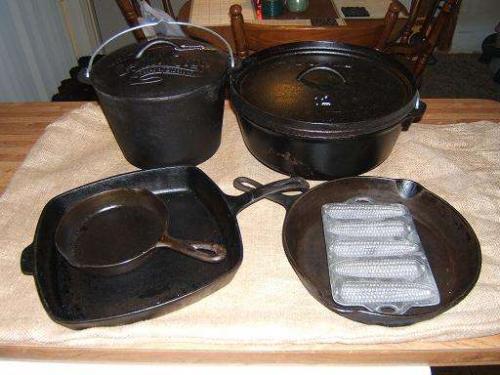Cast Iron Cookware Care and Maintenance
Introduction:
Cast iron cookware has been around for centuries and will most likely be around for more. Its versatility and even heat-distribution has made cast iron cookware a favorite of many cooks. Pots, pans and various other pieces can be purchased new from the store or found for a bargain at yard sales or flea markets and some is even passed down through generations as a family tradition.
And, with proper care and maintenance, an owner of a piece of cast iron can assure that it will last for a lifetime (or several).
In this tutorial, I will show the steps and guidelines I follow to keep my cast iron collection in good condition and ready for anything.
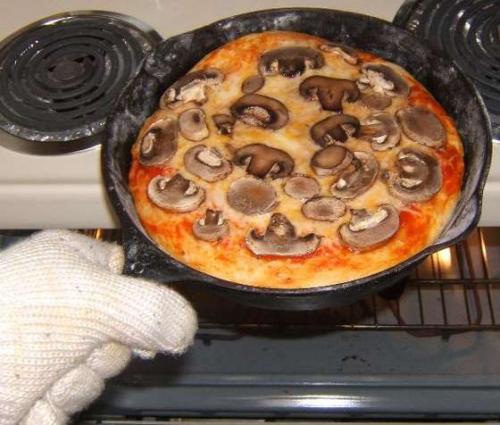
Step 1: Your new piece of cast iron
Cast iron cookware can be purchased from many different places. A person buying a piece of cast iron new from a store can be fairly certain that it is clean and nearly ready to use. However, buying a piece from a flea market may be somewhat different, since it is most likely used. Although it may be dirty-looking, chances are it can be rescued. Try to select a piece that looks to be in good condition, free of cracks and large patches of rust. Smell it and make sure that it hasn't come into contact with harmful chemicals or other liquids. As long as there isn't anything wrong with it that can't be fixed with a little elbow-grease, it is a good piece. Any piece of cast iron, new from the store or used, must be cleaned well before it is used for cooking.
There are several pieces of cookware that are made from cast iron, the most popular being pans, pots, dutch ovens, muffin pans, bread pans and griddles that are made to fit over the burner on a stove.
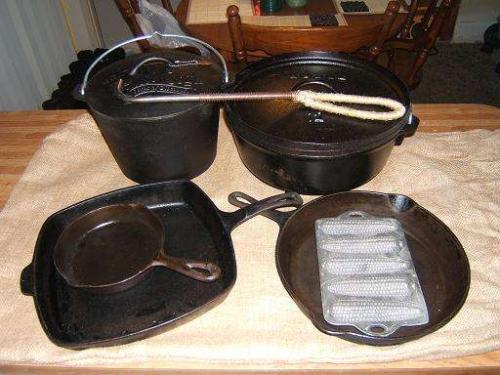
Step 2: Cleaning Cast Iron
All pieces of cast iron must be cleaned before using them in the kitchen. New pieces of cast iron (bare or "pre-seasoned") usually have a thin coating of wax on them to keep them from rusting on the store shelf. Pieces from yard sales or flea markets are most likely very dirty also.
For the first cleaning of a piece of cast iron, it is OK to be a little rough, but remember - never use soap or detergent on cast iron. Also, never put cast iron in a dishwasher. They must be cleaned by hand. The more often cast iron is used, the faster it will build up its own natural non-stick surface (called the "seasoning") and the easier cleaning will become. However, it should be scrubbed well on the first cleaning. The reason for not using soap is simple - on a microscopic level, cast iron is very rough with many crevices for soap to get into. It will stay in there and make food taste like soap. Instead, it is necessary to let it naturally build up the seasoning that will bond to and fill the crevices.
Cleaning is simple - use hot water. The hotter, the better. A sponge with a smooth side and a scouring side works well for this. For the first cleaning, scour it well to remove any wax, stale oil and other bits of built-up grime. Small spots of rust can be scoured until the rust washes away. Problem spots of rust can be rubbed off with a small piece of sandpaper or some type of rotary tool. But remember - bare spots of metal will be very likely to develop rust rapidly, so use care.
After the first cleaning, all other cleanings should be more gentle, with a soft cloth or sponge. Stuck-on bits of food can be left to soak for a few moments in a sink of plain water or scoured off, but remember - you will be scouring away the seasoning that you are trying to build up.
In this photo, I am cleaning a new bare cornbread sheet, a new pre-seasoned bean pot and an old, used pan.
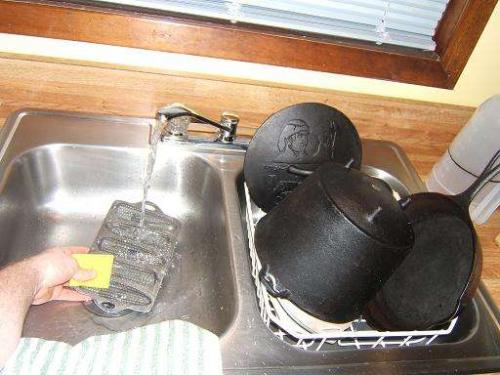
Step 3: The seasoning
After a piece of cast iron is cleaned for the first time, it is nearly ready for use in the kitchen. Some pieces come pre-seasoned with a seasoning already baked on. Other pieces come bare, which is the bare grey metal without any baked-on seasoning. Second-hand pieces that have been cleaned may have spots of bare metal where rust has been cleaned off. All cast iron is vulnerable to rust and it must be prevented.
Natural seasoning is created by the repeated use of pieces of cast iron. Fats, oils and other liquids from the food bonds to the microscopic crevices on the surface of the metal. This naturally prevents rust and creates a non-stick surface similar to the Teflon pans that are popular today.
Prior to using a piece of cast iron for the first time, it is helpful (although not necessary) to bake on a base-coat of seasoning. This first coat is very useful in "breaking-in" a new piece or just adding more seasoning to a second-hand piece.
Pre-heat an oven to about 350 degrees. Using a lint-free cloth or paper towel, wipe oil over the entire piece - not just the cooking surface, do the whole thing. Any cooking oil is OK - olive oil, vegetable oil, canola oil, peanut oil - any type will do. Use a very thin coat of oil. Too much will get gummy on the piece and cause smoke in the oven.
Place it upside down in the oven for 45 minutes and flip it over for the last 15. During this hour, it may smell a little funny, but that is OK. You might want to open a window. The result will be a good coat of baked-on oil that will help to build up the seasoning.
This only needs to be done once, but can be repeated every so often as it helps to solidify the seasoning.
After that is done, take it out of the oven and let it cool off and it is now ready for cooking!
***Please take care NOT to put pieces on cast iron into the oven that have wooden handles. This step is optional and is not safe if any part of the pan is combustible!***
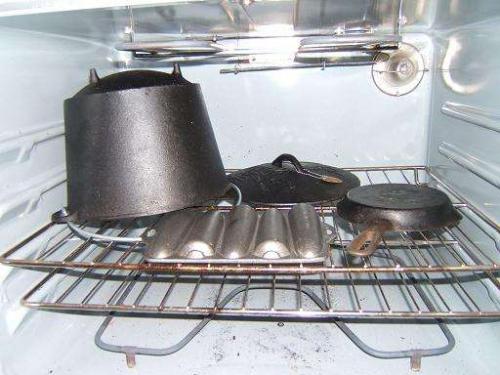
Step 4: Cooking with Cast Iron
Cast iron is very versatile. It can be used on the stove for frying, to sautee, to simmer, etc. You can bake with it in the oven for cakes, cookies and breads, and even on a grill or over a campfire.
Remember that cast iron distributes heat fairly evenly - even to the handle! Don't grab a bare handle if you are cooking with the piece as it will be just as hot as the pan itself. Use a towel, a potholder, a mitten or a glove - anything to protect yourself from a nasty burn.
Metal cooking tools such as a fork or spatula should not be used often on cast iron as it will scrape away the seasoning or expose the bare metal which could lead to rust. Instead, try to use wooden tools as much as possible. Plastic should be avoided as well, since it can melt easily. But, if using metal cannot be avoided, just remember that is has the ability to scrape and remove the seasoning.
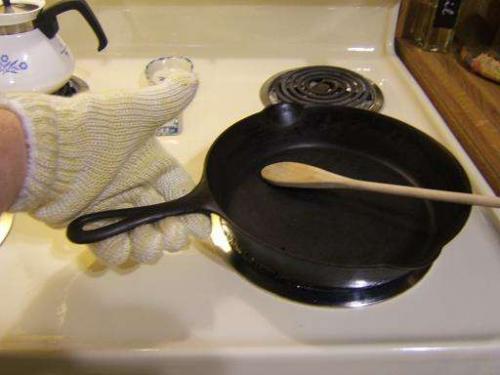
Step 5: Cooking on the stove
Cooking with cast iron on a stove is similar to using any other type of pot or pan. You can use it to simmer a sauce, cook a piece of meat or vegetables, boil water for pasta - the uses are nearly limitless. However, using a new piece may be a little tougher than using an older piece. Older pieces have more seasoning than newer ones which prevents food from sticking.
Generally, you can stick to recipes found online or your own creations. Any cast-iron cooking disaster can be cleaned off afterwards. A little oil or butter on the surface will reduce the risk of food (such as eggs) from sticking. Naturally greasy food like bacon won't need any help.
Food should never be left to sit in a cast iron pan for a long period of time. Acids from food like tomatoes can corrode the surface, and indeed anything can turn stale or rancid and give your cast iron a bad taste. Never put it into the fridge to hold food - transfer it to something else and clean your piece.
To clean it, rinse it in hot water and wipe off any excess oils or pieces of food with a soft rag or sponge. You can soak it for twenty minutes or so to help remove stuck-on bits, but rinsing it off while it is still fairly hot will help also. Just remember the golden rule - No Soap!
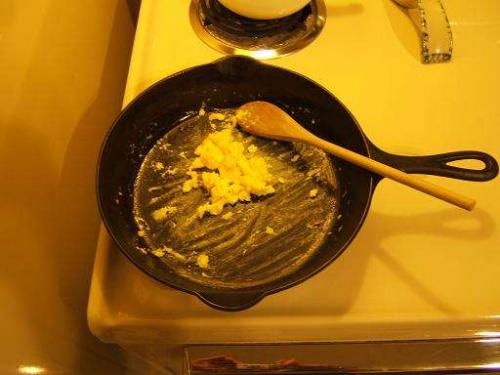
Step 6: Cooking in the oven
Cast iron can be used for baking in an oven as well as on the stove. A cast iron bread pan, muffin pan or cookie sheet will work just as well as the same pans that are used on the stove top.
Cook your favorite breads, brownies, cakes and cookies in a pan or other piece.
To keep food from sticking, use a light coat of cooking spray, oil or even flour.
Pictured here is my favorite to bake - pizza!
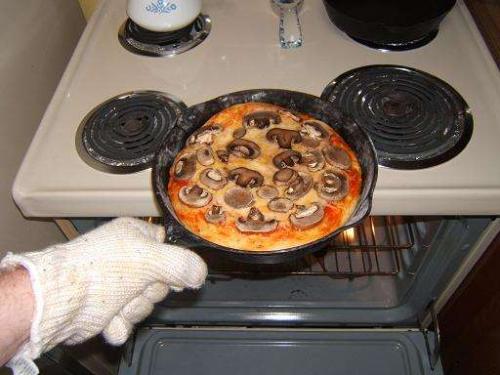
Step 7: Cooking on a fire
Pieces of cast iron can be used for camping and cooking over a fire as well. The most popular pieces to use for this is a dutch oven or a regular pan.
A pan can be placed over the hot coals of a campfire or right on top of them. Take care to use only a small amount of hot coals, since they will most likely create a higher cooking temperature than on a household stove.
A little piece of American history - Lewis & Clarke labeled their dutch oven as the most important tool that they brought along on their expedition into the Louisiana Purchase. And rightly so, too since a dutch oven is very versatile. It can be placed directly onto the hot coals of a campfire or hung above the flames much like a cauldron. The lids of many dutch ovens can be turned upside down and the slightly concave surface can be used like a pan.
Modern-day campers and backyard cooks need not build a fire either, since charcoal briquettes for a grill can be used to simulate hot coals and more accurately control the temperature.
When cooking is done, simply clean as best as possible.
Pictured here is typically how a dutch oven would be used with charcoal.
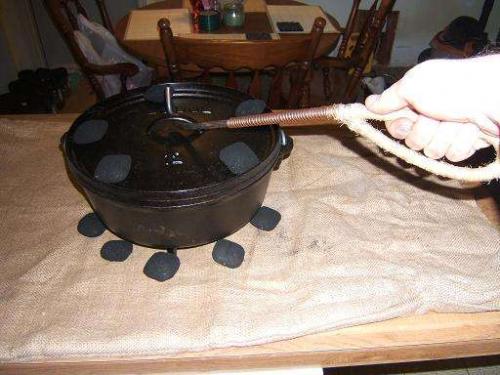
Step 8: Storage of cast iron
Cast iron should be stored clean in a place where there is not a great risk of moisture. Every cook may have a favorite pan or two, but some specialty pieces may not be used for long periods of time.
After cooking, clean the piece of cast iron like normal and allow it to dry completely. It is helpful to take a cloth and wipe on a very thin coat of cooking oil onto the cooking surface. This will help prevent rust - but be careful - too much oil can go stale and taste bad or get gummy. Use the smallest amount possible to lightly coat the cooking surface. Now it can be put away until the next time it is needed.
Any piece that is used regularly can be hung on a hook or placed in the cabinet or wherever the cook wants, but pieces that are used less as often should be stored a little more carefully. Clean them well and apply a very thin coat of oil to prevent rust. Store them in a plastic box or some other closed vessel that will keep moisture out. A bag of desiccant, such as Damp-Gone will assure that the box is dry inside. Pieces stacked on top of one another would benefit from having a rag or paper towel placed in between them. This will prevent them rubbing together and scratching. The box is now ready for storage in a cabinet, attic, garage, etc.
Pieces stored for long periods of time this way would benefit from a good rinse before they are used in the kitchen as well.
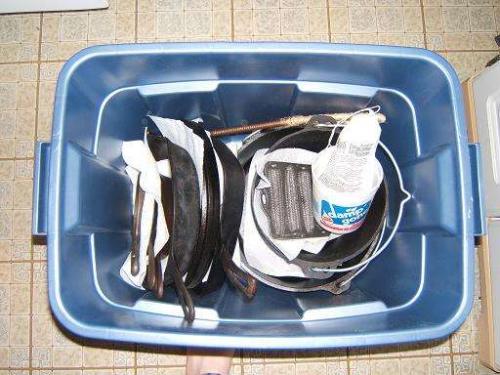
Summary:
I love cast iron cookware. It is versatile, durable and fun to use! Indeed, most any recipe can be made in cast iron.
Other cast iron fans can be found in many places on the internet, such as the International Dutch Oven Society, and other various forums and discussion boards. Recipes made especially for cast iron cooking can be found by using search engines like Google.
Cast iron cooking is a fun hobby and can be enjoyed by many people of many ages. Take the time to care for your pieces properly and you can be assured that they will be around for several generations.
Have fun and happy cooking!
